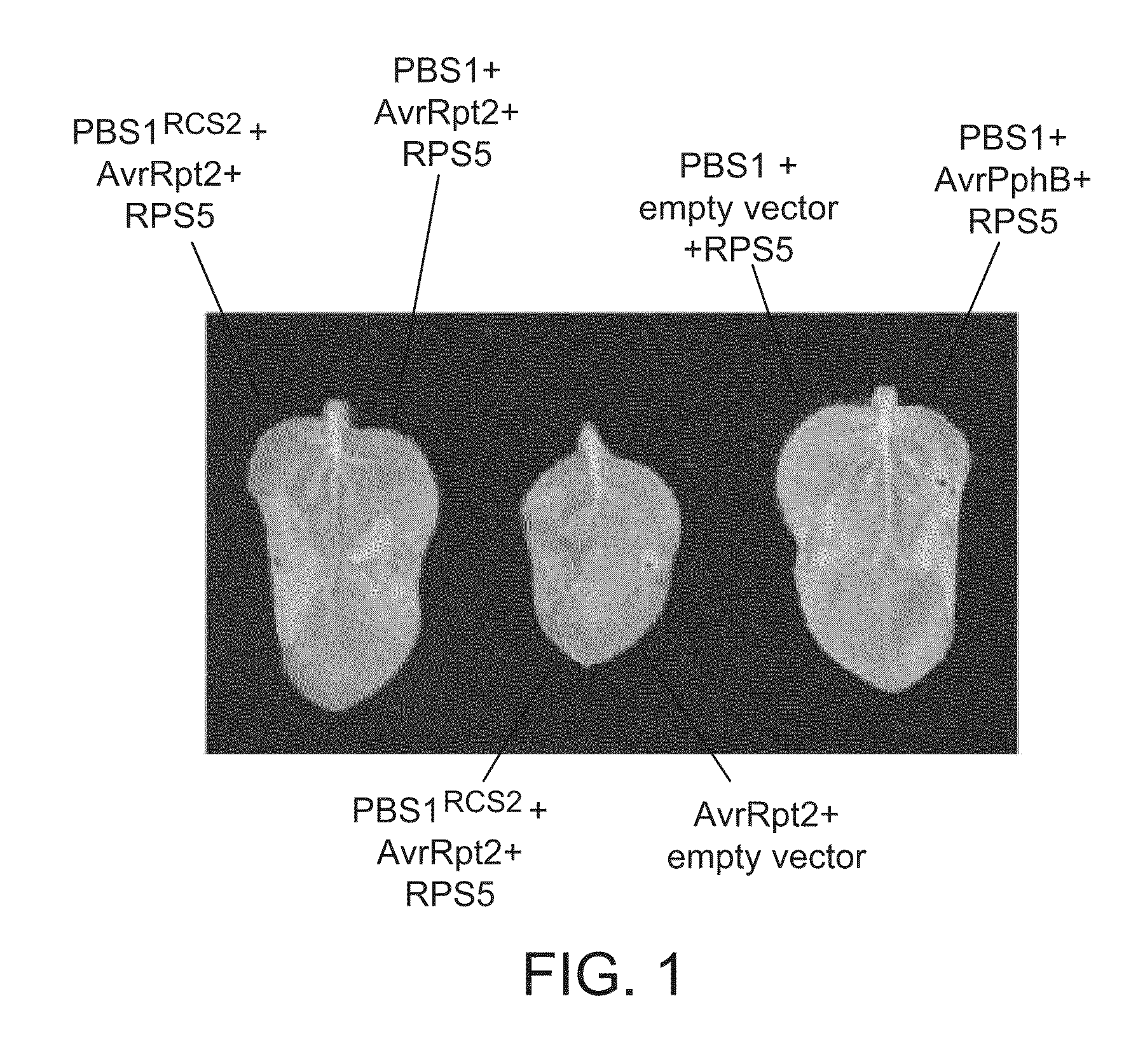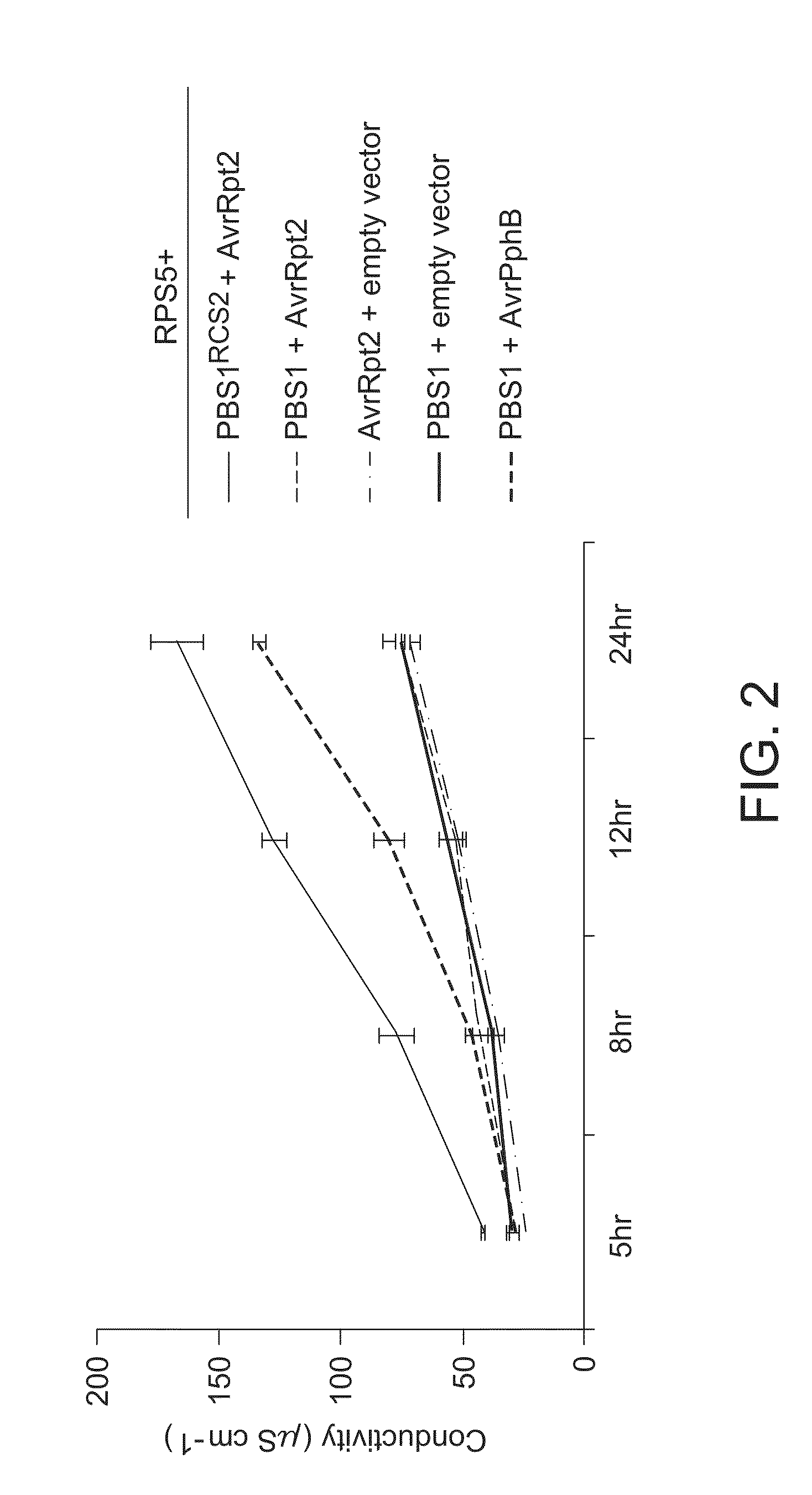Compositions and systems for conferring disease resistance in plants and methods of use thereof
a technology of plant diseases and compounds, applied in the field of plant genetics and plant molecular biology, can solve the problems of time-consuming and labor-intensive conventional breeding methods, affecting the development and history of agricultural practices, and serious limitations of agricultural productivity
- Summary
- Abstract
- Description
- Claims
- Application Information
AI Technical Summary
Benefits of technology
Problems solved by technology
Method used
Image
Examples
example 1
RPS5 Activation by AvrRpt2 when Transiently Co-Expressed with a Modified PBS1 Protein Containing an AvrRpt2 Cleavage Site
Methods:
[0175]Transient Transformation:
[0176]PBS1RCS2 (SEQ ID NO: 4; modified PBS1 containing an AvrRpt2 cleavage site) was inserted in a vector (pTA7002; Aoyama & Chua (1997), supra) containing a dexamethasone-inducible promoter as described in DeYoung et al. (2012), supra. This vector was transformed into A. tumfaciens strain GV3101(pMP90). RPS5 and AvrRpt2 genes also were inserted into pTA7002 (separate constructs) as described in DeYoung et al. (2012) and independently transformed into GV3101(pMP90). For use as controls, GV3101(pMP90) also was transformed with the empty vector pTA7002, and with pTA7002 containing the wild-type PBS1 gene, and with pTA7002 containing AvrPphB, creating a total of six strains (listed below).
[0177]To transiently express these genes in plants, the Agrobacterium strains were prepared as described in DeYoung et al. (2012), supra, mixe...
example 2
Transformation of A. thaliana with Modified PBS1 Protein Containing an AvrRpt2 Cleavage Site Confers Resistance to P. syringae Strains Expressing AvrRpt2
Methods:
[0188]Stable Transformation:
[0189]An A. thaliana mutant line containing mutations in the RPS2 and RIN4 genes (makes A. thaliana susceptible to infection by P. syringae expressing AvrRpt2) was stably transformed with a PBS1RCS2 construct using A. tumefaciens strain GV3101(pMP90) following the protocol of Clough & Bent using resistance to the herbicide glufosinate as a selectable marker. See, Clough & Bent (1998) Plant J. 16:735-743. Five independent transgenic plants were selected. Leaves of these individual plants were inoculated with P. syringae strain DC3000 expressing AvrRpt2 at a concentration of 0.5×107 colony forming units (cfu) per milliliter using a needleless 1 mL syringe. Leaves were scored for visible leaf collapse (cell death) 24 hours after injection. Wild-type A. thaliana was used as a positive control.
[0190]Re...
example 3
Prophetic
RPS5 Activation by a Protease (BEC1019) from a Powdery Mildew Fungus when Co-Expressed with a Modified PBS1 Protein Containing a BEC1019 Cleavage Site
[0191]The genome sequences of several different species of powdery mildew fungi, including species that infect wheat and barley (Blumeria graminis) and species that infect Arabidopsis (Golovinomyces cichoracearum and G. orontii) have been determined. These genomes have been analyzed for the presence of protease enzymes that are likely secreted during infection of host plants. One such protease that is conserved among these fungal species has been identified and has been named BEC1019. Silencing of the BEC1019 gene has been shown to compromise virulence of barley powdery mildew, indicating that this protease is required to cause disease, at least on barley ((Pliego, C., Nowara, D., Bonciani, G., Gheorghe, D. M., Xu, R., Surana, P., Whigham, E., Nettleton, D., Bogdanove, A. J., Wise, R. P., Schweizer, P., Bindschedler, L. V., an...
PUM
| Property | Measurement | Unit |
|---|---|---|
| time | aaaaa | aaaaa |
| temperature | aaaaa | aaaaa |
| temperature | aaaaa | aaaaa |
Abstract
Description
Claims
Application Information
 Login to View More
Login to View More - R&D
- Intellectual Property
- Life Sciences
- Materials
- Tech Scout
- Unparalleled Data Quality
- Higher Quality Content
- 60% Fewer Hallucinations
Browse by: Latest US Patents, China's latest patents, Technical Efficacy Thesaurus, Application Domain, Technology Topic, Popular Technical Reports.
© 2025 PatSnap. All rights reserved.Legal|Privacy policy|Modern Slavery Act Transparency Statement|Sitemap|About US| Contact US: help@patsnap.com



